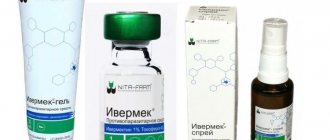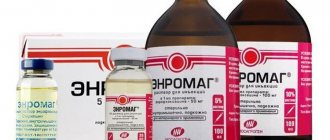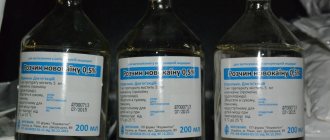Dosage of injection quamatel for cats (1 bottle of 20 mg diluted in 5 ml of solvent):
- 1 kg - 0.25 ml
- 2 kg - 0.5 ml
- 3 kg - 0.75 ml
- 4 kg - 1 ml
- 5 kg - 1.25 ml
- 10 kg - 2.5 ml
Gastric ulcers and erosions are relatively common complications of renal failure, gastric bloating, steroid treatment, nonsteroidal anti-inflammatory drug (NSAID) administration, and primary gastric disease. Drug therapy is often necessary to treat ulcers and prevent further health problems in cats.
Kvamatel is an antiulcer drug of the histamine receptor-2 (H-2) blocker class. Stimulation of H-2 receptors (targets) located on the cell membranes of stomach cells leads to the secretion of gastric juice and hydrochloric acid, in particular. By blocking these receptors, cats' stomach acid will not be released, allowing the ulcer to heal.
Kvamatel and other H-2 blockers are useful in the treatment and prevention of gastric ulcers
(duodenum) and intestines, as they prevent the activation of this cellular receptor. Other drugs with similar effects include ranitidine (Zantac®), nizatidine (Axid®), and cimetidine (Tagamet®). This drug is not approved for use in animals by the US Food and Drug Administration, but veterinarians legally prescribe it as an off-label drug.
- Quamatel is available over the counter but should not be administered to cats except under the supervision and direction of a veterinarian.
- Brand names and other names of quamatela
- This drug is registered for use in humans only.
- Human formulations: Quamatel, famotidine, Pepcid® (Merck) and various generic drugs
- Veterinary drugs: no
general information
The pharmaceutical drug "Kvamatel" is sold in the form of tablets for oral administration and lyophilized powder, from which a solution for injection is prepared. The main component of the drug is famotidine, and it is supplemented by such auxiliary ingredients as:
- food emulsifier E572;
- MCC;
- macrogol stearate;
- PEO;
- povidone;
- food additives E172, E466;
- talc;
- titanium dioxide;
- lactose monohydrate;
- aspartic acid;
- corn starch.
This drug has the same composition, only the tablets themselves are smaller.
Another form of tablets is presented - “Kvamatel mini”, containing similar components in the composition that block histamine receptors and reduce the production of hydrochloric acid, as a result of which the acidity level of digestive juice is normalized. The drug successfully relieves pain symptoms in cats and affects the cause of the disease.
Veterinarians note the following strengths of Kvamatel:
- does not change the production of enzymes and hormones;
- does not affect the functioning of internal organs and metabolism;
- does not have a negative effect on the liver;
- has a rapid, prolonged therapeutic effect.
The tablets are tasteless and odorless, so the cat will not notice their presence in the food and will easily swallow.
Using quamatel for cats
Kvamatel is used in the treatment and prevention of gastric (stomach) and intestinal ulcers in cats. Kvamatel promotes the healing of ulcers in animals with ulcers or erosions (shallow depressions in the gastric mucosa). Kvamatel may be useful in treating stomach inflammation caused by kidney failure. Another use is to treat gastric reflux disease, a condition similar to “heartburn” in humans and caused by stomach acid moving up into the lower esophagus. To reduce damage to the esophagus, this drug is prescribed to cats.
Cats with mast cell tumors can be treated with Quamatel or similar drugs, as these tumors can produce large amounts of histamine.
Kvamatel for cats with diarrhea
Characteristics of the substance Famotidine - quamatel White or pale yellow crystalline powder. It is highly soluble in acetic acid, slightly soluble in methanol and water, and practically insoluble in ethanol.
Pharmacology Pharmacological action – antiulcer. Blocks histamine H2 receptors, inhibits basal and stimulated secretion of hydrochloric acid; inhibits pepsin activity.
It is not completely absorbed from the gastrointestinal tract, bioavailability is 40–45%, increases under the influence of food and decreases with the use of antacids. Plasma protein binding is 15–20%. Cmax is reached within 1–3 hours. 30–35% is metabolized in the liver to form S-oxide and excreted by the kidneys by glomerular filtration and tubular secretion. 25–30% of the dose taken orally and 65–70% of the dose administered intravenously are found unchanged in the urine. T1/2 from plasma is 2.5–3 hours, in patients with severe renal failure (Cl creatinine <10 ml/min) it can increase to 20 hours (dose adjustment required). Passes through the placenta and is excreted in breast milk.
After oral administration, the effect begins within 1 hour, reaches a maximum within 3 hours and lasts 10–12 hours. Under conditions of intravenous administration, the maximum effect develops after 30 minutes. A single dose (10 and 20 mg) suppresses secretion for 10–12 hours.
Use of the substance Famotidine Treatment and prevention of exacerbations of gastric and duodenal ulcers; treatment and prevention of symptomatic ulcers of the stomach and duodenum (associated with the use of NSAIDs, stress, postoperative); erosive gastroduodenitis, reflux esophagitis, Zollinger-Ellison syndrome, bleeding from the upper gastrointestinal tract (as part of complex treatment) and prevention of recurrent bleeding from the upper gastrointestinal tract, systemic mastocytosis, polyendocrine adenomatosis, prevention of aspiration of gastric juice during general anesthesia (Mendelssohn syndrome) . Functional dyspepsia associated with increased secretory function of the stomach. Symptomatic treatment of dyspepsia associated with increased acidity of gastric juice (including heartburn, sour belching).
Contraindications Hypersensitivity, pregnancy, breastfeeding.
Restrictions on use Liver cirrhosis with hepatic encephalopathy, childhood.
Use during pregnancy and lactation Category of action on the fetus according to the FDA - B.
Side effects of the substance Famotidine From the gastrointestinal tract: dryness of the oral mucosa, loss of appetite, nausea, vomiting, abdominal pain, increased activity of liver transaminases, constipation, diarrhea, jaundice; hepatocellular, cholestatic or mixed hepatitis, acute pancreatitis.
From the cardiovascular system and blood (hematopoiesis, hemostasis): decreased blood pressure, bradycardia, AV block, arrhythmia, vasculitis, neutropenia, leukopenia, thrombocytopenia, hemolytic anemia, agranulocytosis, pancytopenia; with parenteral administration - asystole.
From the nervous system and sensory organs: headache, asthenia, drowsiness, insomnia, fatigue, anxiety, depression, nervousness, psychosis, dizziness, confusion, hallucinations, hyperthermia, ringing in the ears.
From the genitourinary system: with long-term use of large doses - decreased potency and libido.
From the musculoskeletal system: arthralgia, myalgia.
Allergic reactions: urticaria, skin rash, itching, bronchospasm, angioedema, erythema multiforme, exfoliative dermatitis, Stevens-Johnson syndrome, toxic epidermal necrolysis, anaphylactic shock.
Other: bronchospasm, dry skin, alopecia, gynecomastia; local reactions - irritation at the injection site.
Interaction When taking famotidine and ketoconazole simultaneously, the absorption of ketoconazole may be reduced. If famotidine is used with antacids, the interval between taking them should be at least 1–2 hours.
Overdose Symptoms: worsening side effects.
Treatment: gastric lavage, symptomatic or supportive therapy.
Routes of administration: Inside, intravenously.
Precautionary measures for the substance Famotidine For patients with impaired renal function (Cl creatinine below 30 ml/min), the daily dose is reduced to 20 mg. It is not recommended to prescribe the drug to children.
When treating gastric and duodenal ulcers, it is necessary to exclude the presence of a malignant tumor in the patient (examination of a biopsy from the area of the ulcer). Use with caution in case of liver dysfunction.
Precautions and side effects
Although Quamatel is generally safe and effective when prescribed by a veterinarian, it may cause side effects in some cats. Kvamatel should not be used in animals with hypersensitivity or allergy to the drug. Kvamatel should be used with caution in cats with kidney or liver disease (dose reduction required). Kvamatel may interact with other medicines. Check with your veterinarian to determine if other medications your pet is receiving may interact with Quamatel. Such drugs include digoxin and ketoconazole.
Indications for prescribing the drug
Kvatemal is recommended for use for ulcerative lesions of the stomach and duodenum. Indications also include situations where it is necessary to reduce the production and acidity of gastric juice, as well as the amount of gastric enzymes produced. Such a need may arise before the introduction of general anesthesia before surgery; taking the medication is considered an excellent prevention of the release of stomach contents into the respiratory tract.
Kvamatel for cats is used for stomach ulcers.
Other indications:
- diagnosed gastric bleeding;
- non-peracid gastritis;
- ulcerative colitis.
Important: The drug is intended for both single and multiple use. It shows effectiveness during one-time attacks and during a long course of intensive therapy. We are actually talking about a universal medicine, the maximum concentration of the main components in the blood is achieved in an hour, the duration of action of the medicine is 12 hours.
Learn about essential drugs in animals
- Vaccination of puppies
- Vaccination of cats against rabies
- Vaccination of small animals
- Vaccination for a kitten
- Why vaccinate dogs against rabies?
- Vaccinations for kittens
- Nobivac triquet trio
- Nobivak dhppi
- Puppy vaccinations
- Vaccinations for cats
- Tick vaccination for dogs
- What vaccinations for dogs?
- Ursofalk for cats
- Serenia for animals
- Ursofalk suspension for dogs, dosage
- Marfloxin for veterinary medicine
- How to use serenia in dogs
- Graying in cats
- Heptor for dogs
- Lidocaine for dogs
- Heptor for cats
- Lidocaine for cats
- Heptral for a dog
- Can cats use marfloxin?
- Marfloxin for cats - instructions
- Heptral in cats
- Dirofen suspension for cats: instructions
- Vetom 1 for cats
- multifel for cats
- Use of fosprenil in cats
^Top
Reviews about the drug
Regina. The doctor prescribed Quatemal for gastritis to the cat; the main advantage of the medicine is that its action is aimed at eliminating the cause of the disease, and not at relieving the symptoms. I always keep the drug in my medicine cabinet just in case; it can also be used to treat people.
Catherine. Quatemal was used to treat an exacerbation of gastric ulcer in a cat, as a result of which the acidity of the stomach increased. It should also be taken into account that taking the drug must be stopped gradually, as the body becomes very accustomed to it. The dose must be reduced gradually; dosage reduction is also indicated for liver diseases and a weakened body.
Karina. The doctor prescribed the drug after severe attacks of gastritis, the cat was given it for several weeks, after which the condition noticeably improved. Quatemal has no side effects; the advantages also include its affordable cost.
Content
1. General description 2. Characteristics 3. Purpose 4. Forms and dosage 5. Limitations 6. Advantages and disadvantages 7. Analogues 8. Cost 9. Reviews
Pets often suffer from the same diseases as humans. In many cases, the same medications are used for treatment as for people - proven and effective. Kvamatel for dogs is used for stomach and intestinal ulcers, other acute and chronic diseases of the digestive system, which are caused by increased production of hydrochloric acid in the stomach.
Release forms and dosage
In bottles – 20 mg of lyophilisate (powder with an ampoule of sodium chloride 0.9%), 5 pieces each; for intravenous administration, under control in a hospital;
In tablets – 20 and 40 mg, for oral administration; excipients – magnesium stearate, silicon dioxide, lactose, corn starch, povidone, talc; tablets are produced in plates of 14 pieces. (1 package contains 28 tablets) or 1 plate contains 14 tablets of 40 mg each.
As a rule, a single dose should not exceed 20 mg, and for cats and other small mammals the standard therapeutic dosage is calculated at a rate of 0.5-1 mg per 1 kg of body weight, 2 times a day. For long-term treatment, Kvamatel is usually used in ampoules (vials) in a hospital setting, and at the first opportunity, furry patients are transferred to tablets.
What are the potential side effects of Quamatel?
For small pets, if any of the following serious side effects occur, stop giving Quamatel and seek emergency veterinary medical attention; allergic reaction (difficulty breathing; swelling of the lips, tongue or face; hives). Side effects are rare but may include loss of appetite and fatigue. Other side effects may also occur. Talk to your veterinarian about any side effect that seems unusual or unpleasant to your pet.
Is it possible?
Kvamatel reduces acidity in the body and the secretion of hydrochloric acid in the stomach. Excess acids can damage the gastrointestinal tract and disrupt normal digestion processes.
Kvamatel is prescribed to dogs for the treatment and prevention of peptic ulcers, gastritis, after operations on the gastrointestinal tract, in case of indigestion due to excess acidity, in the prevention of bleeding and other diseases accompanied by hypersecretion.
Main advantages of the drug
Veterinarians consider Kvamatel an effective and competitive drug due to its pharmacodynamic properties and ease of use.
Kvamatel is produced in tablets and ampoules, in powder form complete with water for injection. Cat owners who do not know how to inject themselves do not have any difficulty giving the tablets to their animals with food, because they have neither taste nor smell. The drug in ampoules is used when oral administration is not desirable (for vomiting, bleeding), and the variability of forms, as well as the different dosage of Kvamatel, expands the range of its therapeutic use.










